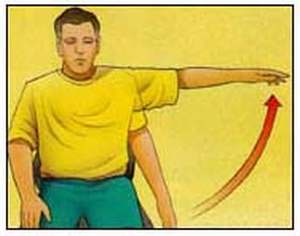

MedFriendly®


Abduct
Abduct means to move or spread away from a position
that is at, near, or parallel to the center of a body.
Parallel means to extend in the same direction without
touching. For example, if you place two sticks next to
each other in the same direction without having them
touch, the two sticks are parallel to each other.
Likewise, the arms and the legs are parallel to the
center of the body. If you stand straight and lift your
arm out to the side, you have abducted the arm by
using the shoulder because you have moved it away
from the center of the body. When the eyes abduct,
they move laterally, away from the nose.
Moving the arm upwards and
out is an example of abduction.
FEATURED BOOK: Eye Movement Disorders
Another example of abduction would be spreading the fingers or moving a finger away
from the middle part of the hand. The same would apply to spreading the toes or moving
a toe away from the middle part of the foot. The term is frequently used in physical
therapy and during physician examinations from physicians, when discussing how well a
person can move their limb(s) in a particular direction.
Compare abduct with adduct, which means to move towards the center. Abduct is also
known as abduce. It is sometimes referred to as abduction. Abduct comes from the Latin
word "abducere" meaning "to take away."
"Where Medical Information is Easy to Understand"™
















